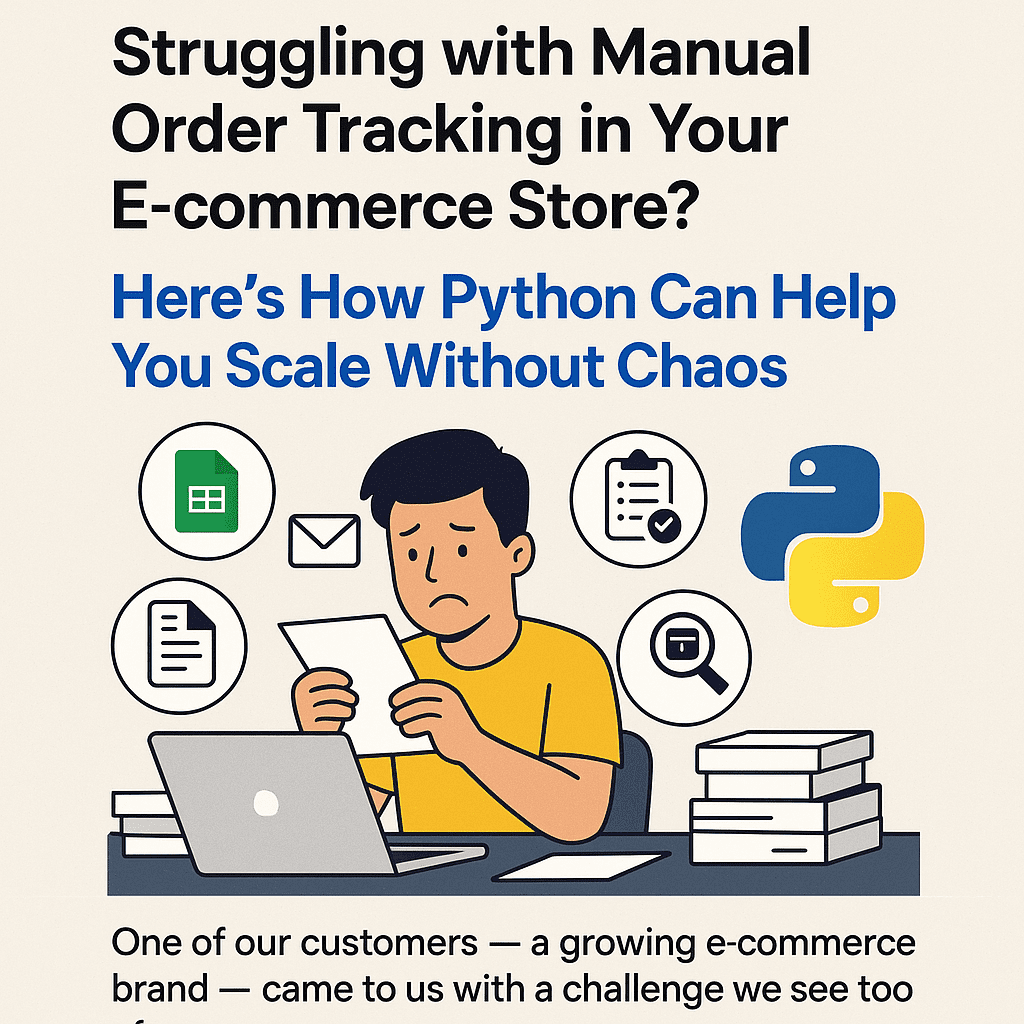Struggling with Manual Order Tracking in Your E-commerce Store? Here’s How Python Can Help You Scale Without Chaos.

One of our customers, a growing e-commerce brand, came to us with a challenge we see too often.
They were handling 150+ orders per month and managing everything manually:
- Copy-pasting order details from Shopify to Google Sheets
- Emailing the fulfillment partner with daily CSVs
- Manually updating stock levels every evening
- Sharing tracking numbers with customers one by one
It worked in the early days. But as their orders scaled, the team started missing updates, overselling out-of-stock products, and spending 3-4 hours a day on basic admin.
This isn’t unique. It’s the reality for many early-stage e-commerce founders, scaling fast but still stuck in manual backend operations.
That’s where automation with Python made a difference.
🔄 What We Did (And How We Can Help You Do the Same)
At ThePythonDevelopers.com, we built a lightweight, scalable solution using Python that now handles their entire order tracking and fulfillment workflow.
Here’s how we approached it:
✅ 1. Real-Time Order Sync
We connected their Shopify store to a Python backend that listens for new orders. As soon as an order is placed:
- It logs the order in a structured Google Sheet
- Sends relevant info to their fulfillment partner
- Alerts the team on Slack
No need to check the Shopify dashboard 10 times a day.
✅ 2. Stock Synchronization
We set up a Python script to sync stock levels between their supplier and Shopify every hour via API. This ensures:
- No overselling of products
- Product availability is always up to date
- They don’t have to manually check stock every evening
✅ 3. Order Status & Tracking Updates
As orders are fulfilled:
- Python fetches tracking numbers from the 3PL API
- Updates the order status in Shopify
- Sends a branded email to the customer via SendGrid
No more missed updates or back-and-forth emails.
✅ 4. Simple Dashboard for Monitoring
Using Streamlit, we created a real-time dashboard showing:
- Orders in various stages (processing, shipped, delayed)
- Out-of-stock SKUs
- Fulfillment turnaround time
Everything is visible at a glance, no more spreadsheets.
🛠️ Tech Stack Used
- Python for scripting and automation
- Shopify API for real-time order and inventory control
- Google Sheets API for live order logs
- SendGrid API for customer email automation
- Streamlit for the internal dashboard
- Optional: Twilio for SMS notifications, Slack API for internal alerts
💼 Why This Matters
If you’re running an e-commerce store and spending time on repetitive backend tasks, your growth will eventually slow down. Manual processes don’t scale – automation does.
This isn’t about replacing your team. It’s about giving them time to focus on marketing, CX, and growth instead of firefighting operations every day.
The best part? You don’t need to buy a $100/month SaaS tool. We build custom automation based on how your store runs — whether you’re using Shopify, WooCommerce, or something custom.
✅ Ready to Simplify Your Fulfillment?
If you’re facing similar issues and want to automate your e-commerce order tracking, fulfillment, and inventory sync, we’d love to talk.
🔗 Visit thepythondevelopers.com or DM me “Ecom Automation” to see what this could look like for your brand.
📩 Ready to automate? Email us at ask@thepythondevelopers.com
#ecommercetools #shopifydev #pythondevelopers #automationagency #orderfulfillment #backendautomation #founderops #thepythondevelopers #ecommercegrowth #inventorymanagement
 Pune, India
Pune, India +91 8960790891
+91 8960790891 ask@thepythondevelopers.com
ask@thepythondevelopers.com
